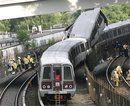Two Metro subway/railroad trains collided between the Takoma Park and Fort Totten Metro stations on the red line just outside Washington, DC, and there are six confirmed deaths and at least 55 or more people injured. Pictures and video from the scene show one of the Metro railroad train cars literally still situated partly on top of a partly crushed metro train that was stationary ahead as the collision was on above ground railroad track. The Metro train which crashed into the rear of the first Metro train was a six car train destined toward the termination point of Shady Grove.

The FBI and the NTSB investigators were at the scene as this article was posted. Washington DC fire spokesman called it a “mass casualty event.” Emergency rescue personnel were using special tools to try to reach persons trapped inside train cars. “We don’t know the number of injuries yet; we know they’ve taken over 60 people off the train,” Metro general manager John Cato told reporters. Apparently, passengers said they had heard announcements about railroad/metro track work being performed on the line prior to the crash. According to news reports, Howard University Hospital and Washington Hospital Center were prepared to receive passengers injured in the Metro train collision, if rescued.
DC Mayor Fenty said at a news conference. “It is my present understanding that this would then be the deadliest accident in the history of our Metro train transit system.”
John Catoe, Metro general manager said: “One train was stopped, waiting to get the order to pass. The next train came up behind. It, for reasons we don’t know, went into the back of that train. We will find what happened and fix what happened.” Preliminary information indicates the operator/conductor of the second, moving Metro train may have died in the wreck.
Watch chopper video of the scene.
Potential Causes
Our railroad injury law firm has handled previous railroad litigation involving an injury to a passenger involved in a similar circumstance where a Metro train collided with the rear of a second stationary Metro train inside an underground Metro stop, that occurred in Washington DC in . As a result of the NTSB investigation, there were multiple causes cited: 1) the Metro train operator allegedly actually fell sleep because of a lack of proper rest, contributing to the rear end collision of the metro trains, 2) there was a failure to have an automatic braking control system that would automatically stop the Metro train if an operator did not respond on a periodic basis to a prompt (a protection device against an operator sleeping, or for some reason being unable to control the train) and there were other contributing causes.
In earlier litigation which are injury law firm handled involving Metro/Marc trains, there was a collision in which a train crew may have improperly passed a signal.
The fact that there was track work ongoing in the area is an ominous sign. It is unclear whether some type of track work may have caused a signal to malfunction, or may have altered the normal Metro train flow through the area.
Other relevant articles by our law firm on railroad injury circumstances: